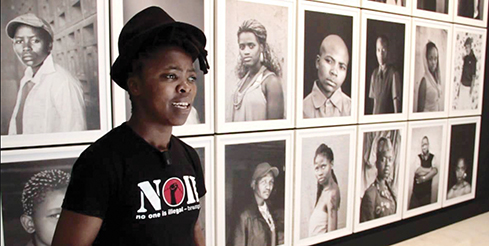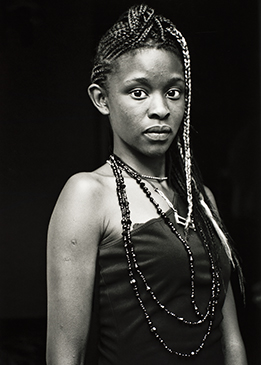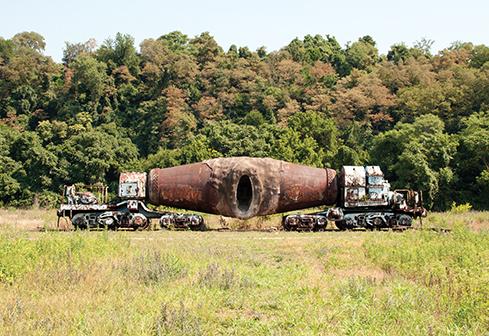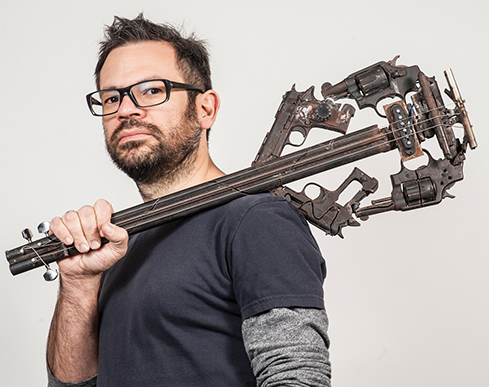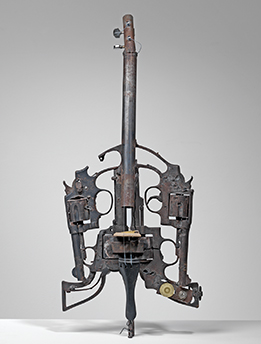 |
||||||||||||
|
Photographer Zoe Strauss hits the streets to get to know the people and places that make up Homestead. She believes the struggling neighborhood is “key to how we think about cities, both living and dying.” Photos: Renee Rosensteel
|
Artist as Activist
Contemporary art often speaks to injustice. But these artists use their work to turn conversation into change.One Monday in July, Zoe Strauss drove the Pennsylvania Turnpike from her home in south Philadelphia to a hotel just off 8th Avenue in Homestead. It was one of several trips she made over the course of the year to prepare for the 2013 Carnegie International. Through portrait photography and site-specific video projections, the artist is exploring Homestead’s history of collapsed industry, the ramifications of poor urban planning, and yet, the forward momentum of the community today. Beginning this September, she’ll have a studio in the Monongahela River town and offer complimentary portraits to community residents and workers, and as they’re completed the portraits will be on view as part of the International. This day in July, though, Strauss is thinking about numbers; about currency, and how the portraits she takes in Homestead could make an economic impact there. “I was trying to figure out how much I can present each photo for,” she says, knowing that when the museum enters each image into the exhibition, the dollar value she assigns will become the portrait’s real-world price. To realize the importance of this value, it’s first necessary to understand the principles of Strauss’ work. Starting in 2001, she dedicated herself for 10 years to a project called I-95 in Philadelphia, the theme of which she describes as “literally everything” and “without exaggeration, the equivalent of an epic poem.” Each year for a decade she showcased a sprawling exhibition in an underpass beneath Interstate 95, a concrete space that ran approximately one block wide and two blocks long. Through her images, she explored themes like gender, addiction, American identity, and the choices people make to get by. “I come from a lower-middle-class, working-class family with a lot of complexity,” she says. “My mother also has a very strong interest in culture in general, and that was a great impact.” Her project for the 2013 Carnegie International, opening October 5, is similarly ambitious yet in some ways more formal. The shift from street photography to studio portraiture is for Strauss an important one in this community: “With street photography, there is this tremendous imbalance of power,” she says; the photographer gets to choose in what context to portray the subject in a given moment. “For the portrait studio, it will be how people want to be seen,” she notes. In Homestead, residents will be able to exert a certain control over how they and their community are represented. The images will also take inspiration from the work of a portrait photographer operating across the street from Strauss’ new studio—featuring a straightforward style and a simple, consistent backdrop. Strauss will maintain an essential element of her practice: Whenever she exhibits a photograph of a person, she gives that person a copy. So when her portraits are entered into the 2013 Carnegie International, their assigned values will also extend to their duplicates, resting in the hands of dozens of Homestead subjects. One price tag Strauss mentions as a possibility: $1,000. “It’s like printing money,” Strauss says. “Homestead has struggled to find a place from the time of the strike [in 1892]—literally from the Pinkertons’ landing—until now,” she notes, referencing the infamous, deadly labor dispute at Carnegie Steel Company (known today as U.S. Steel). Yet, she insists, “It’s not about restitution. It’s just about: This is where we are now. How do we move forward?” “Moving forward” is a key idea for several artists participating in the 2013 Carnegie International. In previous decades—for instance, the late ’80s and early ’90s—works with identity-based or political agendas were often far more rooted in the past, says Dan Byers, co-curator of the 2013 Carnegie International along with Daniel Baumann and Tina Kukielski. “Since then, artists have tried to make work that is more complicated, that doesn’t just point out the problem or illustrate inequities, but that inhabits the kind of world that they would like to see.” Within the 2013 Carnegie International, there are those who adopt the moniker of “activist,” championing a particular cause, and those like Strauss who aim, more subtly, to be the facilitators of dialogue. She insisted, for example, that Homestead residents and union steelworkers be given free admission to the museum during the run of the International. At their core, these artists all seek to bring their work outside of the museum, to participate in the ebbing and flowing of ideas, and, ultimately, to effect change in Pittsburgh and beyond. Visual ActivismHistorically, says exhibition co-curator Daniel Baumann, there have always been artists who thought they were going to change the world. “Now,” says Baumann, “I think these artists became more pragmatic.” They speak two languages, he says—one driven by cause and the other by aesthetic—and they accept the fact that their art may have different messages, make different connections, and serve entirely different purposes in the disparate settings of the museum and the community.
South African photographer Zanele Muholi falls into that mix. “She happens to make beautiful, striking photographs, but the photographs have a function beyond art,” says co-curator Byers. Muholi, a self-described “visual activist,” has worked for 10 years to document the existence and identities of black lesbians in South Africa. “Homosexuality is seen as un-African,” says the artist, noting that her culture’s expectation of African women is to have children with a man. “Failing to conform to the societal expectations of womanhood, we are perceived as deviants.” Though South Africa was the first country to draft a constitution explicitly forbidding discrimination based on sexuality, violent hate crimes against the gay community persist, often through brutal methods like “curative rape” and even murder. In 2012, at least 10 South Africans in the LGBTQ community were killed in hate crimes, the majority of them black lesbians and many of them under 30. In 2006, Muholi began Faces and Phases, a project that seeks to compile 500 portraits of South Africa’s lesbian community, “to showcase our existence and resistance in this democratic society, and to present positive imagery of black lesbians,” she explains.
This year, as part of the 2013 Carnegie International, Muholi is debuting her images in the United States, and seeking to add a new dynamic to the ongoing conversation about LGBTQ issues in Pittsburgh and across America. She will partner with the nonprofit New Voices Pittsburgh: Women of Color for Reproductive Justice, and will appear on the locally produced podcast “Queer & Brown in Steeltown.” “We will face our experiences, whatever they will be, and we’ll still move on.”
- Zanele MuholiHer work within the community, and as part of the community, underscores one of the fundamental principles she assigns to her brand of “visual activism”: Muholi wants to put a face on every issue. In this case, it is her own. For her community in South Africa, her goal is one of reclaiming identity. “We will face our experiences, whatever they will be,” she says, “and we’ll still move on.” Because it MattersShortly after arriving in Homestead, Zoe Strauss planned to meet an acquaintance for dinner. She walked from her hotel in the Homestead corridor known as “the Avenues” to a favorite nearby locale, Blue Dust, to find it closed on Mondays. She went up the street, to Smoke, a barbeque joint, but again found the doors locked. So she turned and walked across the railroad tracks to a chain restaurant in The Waterfront, an open-air shopping mall that sits on 430 acres that was once Homestead Steel Works. Along the way, she encountered stretches without sidewalks and difficult intersections for pedestrians. At one point, she stopped. “This is ridiculous,” she said. “What is this right now?”
Later over dinner she reflected on the urban planning decisions made after the collapse of the local steel industry. “So often [history] is presented as being very remote,” she says, “when in truth it’s really a part of the continuation of our lives.” In Homestead her mission is not a heavy-handed one. She wants to facilitate a conversation about how the community exists now. “Homestead is key to many places,” she says, “in terms of community, city planning, government, and construction. I think Homestead matters a great deal in terms of how we think about cities, both living and dying.” As such, a portion of her project features a video installation of scenes from Wuhan, China, a presentday center of steel production. The central China town is facing a downturn in industry and will soon make the decisions—like those made in Homestead— that will affect the fundamental ways its residents are able to live their lives years in the future. “We need to be able to take a look at what happens here,” Strauss says, “because—I don’t even need to finish. Because.” DisarmingThe most important aspect of making change is not to complain, says Pedro Reyes, an artist and sculptor from Mexico City. “You need to literally become the problem yourself,” he says. “Once you feel that you are the problem, you start to see also that you are the solution.”
For years Reyes has undertaken an overarching campaign to reduce the number of guns in Mexico. “Both Mexico and the United States have suffered a lot from gun violence,” Reyes says. “I don’t like complaining or being depressed or afraid, so I had to somehow make that part of my artistic process.” His practice involves using guns as a raw material for sculpture. In 2008, he began Palas por Pistolas, which called for the voluntary donation of guns to be destroyed and melted into shovels. During the first campaign, 1,527 weapons were collected and turned into 1,527 shovels, which have been used to plant at least as many trees. “It is a kind of up-cycling,” says Reyes. “An agent of death becomes an agent of life.” Initially based in Culiacán, a city with one of the highest rates of gun-related deaths in Mexico, the project is now being replicated around the world. Soon, his work piqued the interest of officials in the Mexican government. “They were trying to change their strategy,” he says. “Just increasing the number of jails and the number of policemen in the streets was not leading to an improvement in making communities safer.” In 2012, Reyes got a phone call: Officials were in possession of 6,700 guns that had been seized from Ciudad Juárez, then considered the most dangerous city in the world. Normally they would bury or destroy the weapons, but this time, they thought: Maybe Reyes could use them?
“You can do very fast or intensive performances, as well as ones that have a lot of space and can last for hours,” says Reyes. These sounds will echo throughout Carnegie Museum of Art’s grand Hall of Sculpture during a series of automated and live performances in partnership with local musicians from the University of Pittsburgh and Carnegie Mellon University. Reyes also plans to lead a workshop for the musicians to create their own instruments from guns seized within Allegheny County. “It is a kind of up-cycling. An agent of death becomes an agent of life.”
- Pedro ReyesThe transformation of the metal, Reyes hopes, will cause a reverberating shift within the individual and throughout society. He imagines a day when actors decline to use guns in films, the way some have refused to smoke on screen. “We need to create a cultural rejection,” he says, acknowledging that this is a long-term goal, propelled for him by the notion that the solution is infinitely more interesting than the problem: “When you are thinking of the problem, and have identified the cause of the problem, you are somehow satisfied, and your mind stops thinking. But when you are thinking of the solution, you have to readjust all the time. Your mind is active. It is a creative process,” he says. A handful of other artists in this year’s Carnegie International consider societal problems, and their solutions, in their art. Israeli artist Yael Bartana, whose films center on cultural and religious displacement, and Indian documentary filmmaker Amar Kanwar, whose mixed-media installation spotlights the social and environmental impact of mining on the community of Odisha, India, are among them. The prevalence of obvious activism among the world’s contemporary artists is evidence of a new emphasis on an age-old question, says Baumann: What is the role of art in society? “They all still work that question, on art that is socially relevant; but without being naïve about it.” Over dinner at The Waterfront, Zoe Strauss runs through her trip’s to-do list: “I have to film a lot. I have about 500 or 600 meetings,” she says. “But I also have to go visit Diane, who is someone I met on the corner at 8th and Amity. She just got water turned on.” For Strauss, this is how the work begins. She’ll live in Homestead full-time for four weeks before and two weeks after the exhibition’s opening, meeting people in the community and hearing their stories. “There are any number of levels I am interested in and hoping people will think and talk about. It wouldn’t have to be immediate,” she says. “I’m happy to be long dead before people are like: That seems like it made sense.” After dinner, she lugs her camera off the seat and onto her shoulder and heads back across the tracks to Homestead.
|
|||||||||||
2013 Carnegie International · History Redux · Artists In Their Own Words · Frozen In Time · The Stand-In · Director's Note · NewsWorthy · Face Time: Lauren Talotta · Science & Nature: Cultural Craftsman · About Town: Wild by Design · The Big Picture
 |
Copyright © 2017 CARNEGIE Magazine. All rights reserved. |

